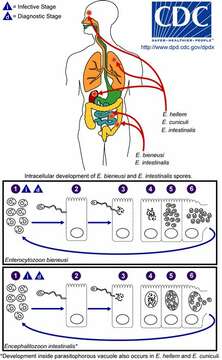General microsporidian life cycle

Description:
General microsporidian life cycle
The infective form of microsporidia is the resistant spore, which can survive for long periods in the environment (1). The spore extrudes its polar tubule and infects the host cell (2). The spore injects the infective sporoplasm into the eukaryotic host cell through the polar tubule (3). Inside the cell, the sporoplasm undergoes extensive multiplication either by merogony (binary fission) or schizogony (multiple fission) (4). This development can occur either in direct contact with the host cell cytoplasm (e.g., Enterocytozoon bieneusi) or inside a vacuole known as a parasitophorous vacuole (e.g., Encephalitozoon intestinalis). Either free in the cytoplasm or inside a parasitophorous vacuole, microsporidia develop by sporogony to mature spores (5). During sporogony, a thick wall is formed around the spore, which provides resistance to adverse environmental conditions. When the spores increase in number and completely fill the host cell cytoplasm, the cell membrane is disrupted and releases the spores to the surroundings (6). These free mature spores can infect new cells, continuing the cycle.
From Centers for Disease Control Parasites and Health website.
Included On The Following Pages:
- Life
- Cellular
- Eukaryota (eukaryotes)
- Opisthokonta (opisthokonts)
- Nucletmycea
- Fungi (mushrooms, lichens, molds, yeasts and relatives)
- Microsporidia (microsporidian parasites)
- Microsporea
- Dissociodihaplophasida
- Nosematidae
- Nosema
This image is not featured in any collections.
Source Information
- license
- cc-by-nc
- copyright
- Centers for Disease Control/Division of Parasitic Diseases and Malaria
- publisher
- Shapiro, Leo
- photographer
- Centers for Disease Control/Division of Parasitic Diseases and Malaria
- provider
- EOL Rapid Response Team
- original
- original media file
- visit source
- partner site
- EOL staff
- ID


